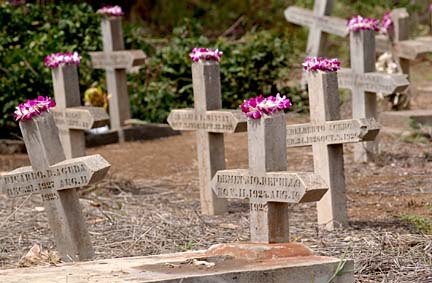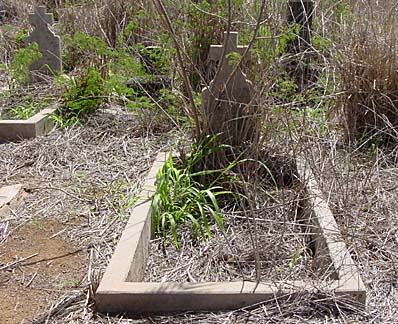
FL MORRIS / FMORRIS@STARBULLETIN.COM
Volunteer Kyung Hee Lee, above, washed a headstone yesterday during a cleanup project at the Pu'uiki Cemetery in Waialua.
A community project aims
to restore island cultural
heritage in Waialua
Emalia Lindio died in 1925 before her first birthday. Her grave, its concrete cross calcified with time, lies in the large children's corner of the Pu'uiki Cemetery that is the final resting place for several generations of immigrant workers who worked the now-closed Waialua Sugar Plantation.
Emalia's grave lies in a grouping of other crosses, some broken or toppled, of about a dozen children who died from some sickness that might have swept through the plantation and town of Waialua in 1925.
Until recently, Emalia's headstone was forgotten in shoulder-high grasses and haole koa saplings.
Yesterday, the gravesite was remembered with a purple orchid lei -- one of more than 700 leis that the Korean Chamber of Commerce and the Korean American Coalition of Hawaii placed on headstones as part of an ongoing cleanup and restoration of the plantation cemetery. The project coincides with the 2003 Korean centennial. About 140 people showed up yesterday to scrub tombstones, haul away branches and hack weeds.
Last January, as part of the Korean centennial, the Korean Chamber installed a commemorative statue by Korean artist Bou Chan Park among the graves at Pu'uiki.
Chamber Vice President Andre Lee said, "We noticed the condition of the cemetery and thought it was the right thing to bring it back, to honor our ancestors."
FL MORRIS / FMORRIS@STARBULLETIN.COM
Graves of children in the cemetery show the effects of the volunteers' tender attention.
Several years ago, a small but stubborn group of volunteers began hacking down the 10-foot trees and invasive 6-foot grasses that obscured the headstones. They enlisted the help of family, friends, soldiers from Schofield Barracks and even students from Waialua High School.
"But the Korean Chamber has brought us to a new level," said Mike Miura, one of those early volunteers.
Miura's great-great-grandfather, Fusakichi Miura, emigrated from Japan to Waialua in 1890 at the age of 18 to work the plantation. He married a picture bride and later founded a dry goods store that still exists. Miura has ancestors with headstones in Pu'uiki.
Miura said the chamber has brought in heavy equipment and is trying to raise about $45,000 to save the cemetery. About $24,000 of that is for a fence. Miura and others say they want to plant grass and native plants on what is now a scorched, dusty plot with a few stands of sunflowers, plumeria and native plants.
The cemetery, like the sugar plantation, shows the waves of different immigrants who were brought to Hawaii to live and die by the growing cycles of sugar cane. Just as the plantation luna tried to divide the plantation workers ethnically using different pay scales and disciplinary practices, the cemetery is roughly segregated into areas for Hawaiians, Koreans, Chinese, Japanese, Koreans, Portuguese and Filipinos.
Miura said that chamber members noticed that Japanese and Hawaiian volunteers were clearing sites that were Korean and Chinese.
PHOTO COURTESY OF ANDRE LEE
Some of the graves at Pu'uiki Cemetery in Waialua have degraded after years of neglect.
"They asked us why we would do this, and we said that some others did the work for us, so we were doing the work for them," said Miura, who dismisses the ethnic divisions of the past.
So far, 36 Korean graves have been identified of the 715 catalogued at Pu'uiki. Lee said the Waialua plantation is important to Korean Americans because the first organized group of Koreans to arrive in Hawaii in 1903 worked at Waialua.
Nanette Napoleon, director of the Hawaii Cemetery Research Project, which has catalogued information from headstones in Oahu cemeteries, said Pu'uiki "is a typical plantation cemetery, just the way it shows the ethnic diversity of the plantations."
Napoleon sees cemeteries such as Pu'uiki as an outdoor museum with artifacts that detail the multicultural history of Hawaii. She said the tombstones often have inscriptions that give valuable genealogical clues and information about ancestral homelands that are not available in any other record form.
The Pu'uiki cemetery has sections that are Hawaiian with Christian crosses and ones that are Japanese featuring altars for burning incense. Some of the Portuguese ones, which are Catholic in theme, feature pictures of the deceased.
But as sugar failed or families left the plantation and their ancestors behind for new lives, Pu'uiki, like many other small plantation cemeteries, fell into disuse and neglect. Nature reclaimed the land, with Australian grasses once imported to feed cattle now wildly growing 6 feet tall over huge swaths of Oahu.
"Each tombstone is a story, each tombstone is connected to a life," said Jere Choo, whose great-great-grandmother, Kahanawale Kaui, granted the 5.5 acre plot for Pu'uiki sometime in the 1880s.
In many cases, there are no living descendants to tell the stories of those who rest here.
Several years ago, Choo sought to find his roots and learned of his great-great-grandmother who died in 1919. She inherited a few acres of land in Waialua and by raising hogs and produce was able to accumulate about 75 acres. She had a few run-ins with the plantation owners who wanted her land. She gave them one plot they needed in exchange for a modest house.
A few years ago, Choo, 63, cut a path to his great-great-grandmother's Christian-cross-styled grave in what is considered the Hawaiian/Portugese section of the cemetery. His family restored the tombstone and adorned the area with plantings.
Miura, like Choo, is also saddened that some stories of people are lost. He said sometimes he stops in front of a headstone and wonders "Why did this Portuguese lady leave her home? What is her story? Does anyone remember?"



